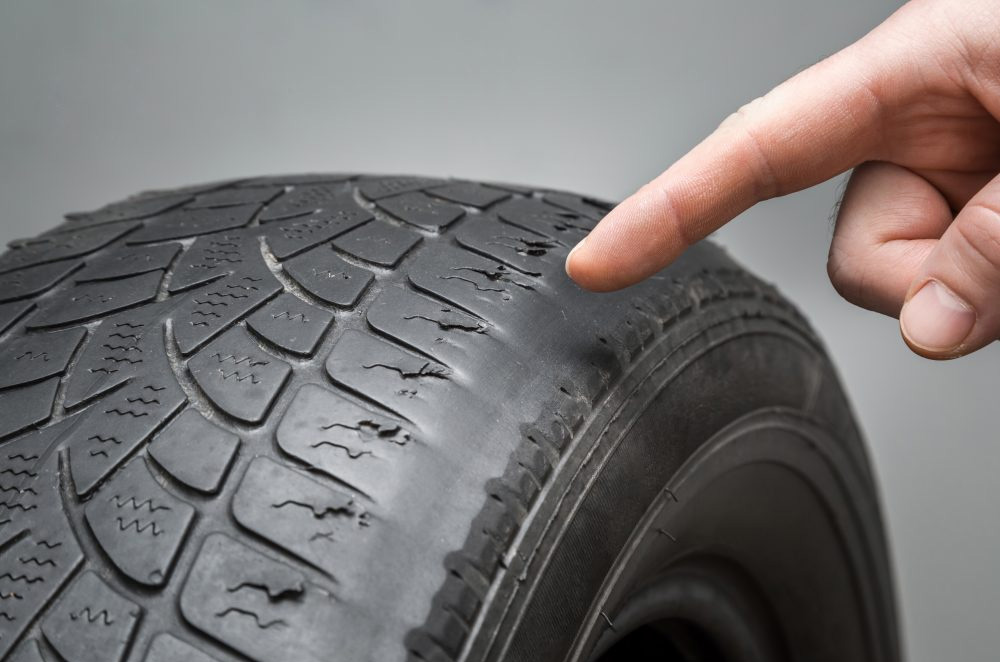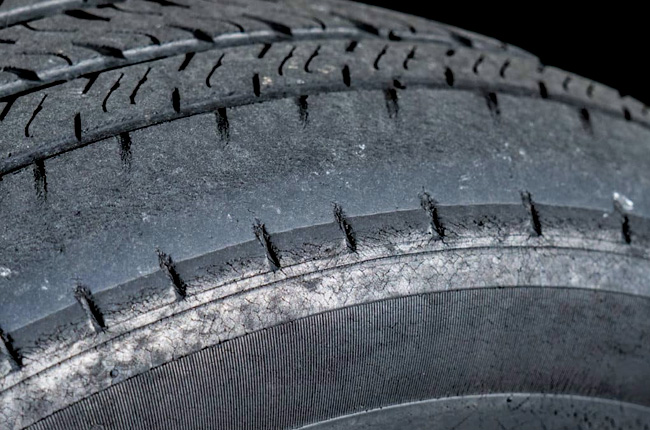
Tires are your vehicle’s main connection to the road, and if they fail you will lose traction and could end up in a crash. Knowing what kind of damage could happen to your tires and how to protect them from it could be valuable information to know especially if you frequently drive your vehicle. With that said, we have created a quick guide to help you understand the common types of tire damage, how they happen, and what you can do to protect from them.
Tire punctures

First on the list of common tire damage are punctures. These happen when a small sharp object penetrates the tread of the tire. Punctures get serious when the object manages to find its way deep enough into the tire to allow air to escape. This will cause a range of problems that are not limited to, loss of grip with the road and reduced handling.
Punctures generally come in two main types. The first is a slow puncture while the other is a rapid puncture. From the names alone they indicate what kind of effects they can have on your tire. Slow punctures can be identified by looking for small sharp objects that have penetrated the tread of your tire. If you find an embedded object it is ideal to leave it in the tire to avoid more damage or to swap that tire out with a spare. If you notice that your tire loses pressure slowly then it is best to bring it to a tire repair shop immediately and have them patch it up.
Rapid punctures on the other hand are more obvious as their effects can immediately be felt as it can inhibit your ability to drive. Your tire will quickly lose air pressure and you will notice the effects on your vehicle’s handling. Similar to a slow puncture you can visually inspect your tire to see if there are any objects stuck in it.
Fixing a puncture
In the event that you are driving and you get a puncture, you might need to carry out a roadside repair. It is important to note that punctured tires are still repairable, although depending on the damage the repair could only be a temporary fix and a new tire will be needed as soon as possible. If you want to try and fix the puncture on your own you can purchase any tire repair kit and following the instructions or utilize a kit that uses sealant that can plug the hole for you. Either way, it will allow you to inflate your tire and get you to where you need to go. It is still best to swap out the punctured tire with your spare and bring the compromised tire to a tire repair shop so that a professional can do the job.
Tire wall damage

A tire wall is the outward-facing part of the tire that surrounds the outward-facing part of your wheel. These are typically made of strong materials that can not only withstand the pressure of the air inside the tire but can also handle being damaged by daily use.
When it comes to tire wall damage, these typically come in two forms. The first of which are bulges that are caused by impacts that weaken the structural integrity of the tire. This, in turn, causes a weak spot to occur making it easier for a bubble to form creating a bulge. The other form of common tire damage are cuts. These are created when the vehicle drives over sharp objects while having low tire pressure. If your tire has low air pressure it can cause the surface of the sidewall to end up in contact with the road. In order to find out if your tire has damage, a visual inspection is needed as most signs will be visible.
Fixing tire wall damage
When it comes to tire wall damage there are no fixes to this. The structural integrity of the tire is already weakened at this point and is considered no longer safe to drive. As such, a replacement tire is the only way to “fix” the problem.
Cracks

Cracks can appear on the sidewall or on the tread of your tire. These can be caused by numerous factors which include bad road conditions, the tire’s age, and excess exposure to UV rays. While minor cracks aren’t things to worry about a major crack will require immediate attention as this could cause your tire to burst at any given time.
When inspecting your tires make sure you check the inner and outer surfaces as well as the tread grooves and the sidewalls. These will be easy to spot as these cracks will often be visible to the naked eye.
Fixing a cracked tire
Similar to tire wall damage, fixing a cracked tire is no easy task as the damage caused could already affect the structural integrity of the tire and its ability to hold air. In the case of small cracks, these will get bigger over time and as such you will need to find a replacement later down the road. It is still best to replace the tire immediately if a crack has appeared near or around its sidewall. If cracks appear on the tread itself and aren’t too deep, then your tire is still usable but a replacement is still advisable.
Irregular tread wear

Irregular tread wear is a less obvious form of tire damage as these can happen over a long period of time. The effects are not easily seen or felt immediately. There are several types of irregular wear that affect a tire in multiple ways. However, all of these three kinds of common irregular wear affect the traction of the vehicle as well as its handling.
First on the list is heel and toe wear. This is caused by the normal tire usage, this is a minor problem, however, if it gets worse over time then it is highly recommended to have your vehicle aligned or the tire replaced. This caused by the tread blocks on one side wearing out faster than the other as they rub against the road.
The second is one-sided wear which happens when your wheels are misaligned on their axis. This can happen on either the interior or exterior of your tire depending on how your vehicle’s alignment has been affected, as a result, it causes uneven wear on your tire’s tread.
The third kind is center wear, as the name suggests, only the center portion of your tire’s tread gets worn out. This happens when the tire is overinflated and the center part of the tire bludges out from the pressure. As a result, the center part of the tire takes the brunt of the force from its interaction with the road resulting in faster wear in that section.
Fixing irregular tire wear
If you manage to spot the early signs of irregular tire wear by visually inspecting your wheels then you can still save your tires. All you will need to do is have your vehicle aligned to resolve the issue. If however, the damage is too severe, you will need to buy a new set of tires and then have your vehicle aligned again. It is important to note to always have your tires replaced in pairs or as a set in order to have them wear out as evenly as possible.
Tire burst

A tire burst is one of the more dangerous forms of tire damage that can occur. This happens when the structural integrity of your tire has been compromised and completely loses its ability to hold in air. A tire burst can happen any time but more commonly happens to vehicles that already have damage to their sidewalls such as cracks or cuts. Through regular driving, these cracks and cuts can grow larger if left uncheck and can result in a tire burst. A tire burst will immediately affect your vehicle’s handling and its ability to steer.
In order to prevent tire bursts from happening, it is best to always give your tires a visual inspection. From there you can see if its sidewall has been compromised or if there are other forms of damage on it.
Fixing a tire burst
Once a tire burst happens to your vehicle there is no way of saving your tire. This will require you to replace it immediately with your spare tire in order for you to get to a tire shop to buy a replacement. The only safe solution is to replace the burst tire with a new one.
Latest Features
-
An all-electric future: The Porsche Macan Electric / Featured Article
Porsche’s Macan goes all-electric; it’s a new beast with an electrified heart, yet unmistakably Porsche in performance and spirit.
-
Which Kia should I buy? / Featured Article
We’re here to help you decide which Kia vehicle is best for you, whether it’s a sedan, crossover, or minivan.
-
Why Lynk & Co is a good option for luxury car buyers / Featured Article
Lynk & Co offers premium value for those exploring the luxury market.
Popular Articles
-
Electric Vehicles in the Philippines for under P1 million
Jerome Tresvalles · Aug 19, 2025
-
Top 3 Cars For Every Lifestyle—What Cars Are Right For You? | Behind a Desk
Caco Tirona · Apr 24, 2024
-
5 Tips to Maximize Fuel Efficiency
Jerome Tresvalles · Sep 09, 2024
-
Five driving habits that are draining your fuel tank
Jerome Tresvalles · Jun 24, 2025
-
Can engine braking harm your engine?
Jerome Tresvalles · Sep 11, 2025
-
Do electric cars even need maintenance?
Jerome Tresvalles · Oct 23, 2024
-
Best vehicles for an active outdoor lifestyle
Shaynah Miranda · Jul 25, 2024
-
How to drive different types of vehicle transmissions
May 23, 2024
-
5 easy ways to keep your car interior clean
Allysa Mae Zulueta · Nov 15, 2021
-
How to survive Metro Manila traffic
Earl Lee · Aug 16, 2022



